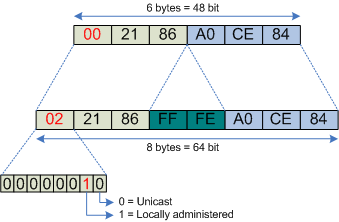EUI-64
EUI-64 or Modified EUI-64 are often used as the lower 64 bit of a IPv6 Address.
EUI-64
EUI-64[1] or Extended Unique Identifier is a 64 bit Global Identifier administered by IEEE[2]
Examples of use
FireWire[3] and in IPv6 as least significant 64 bits in Link-Local and Global Unicast if Stateless Autoconfiguration. (Except Systems that will choice a Random page fx. Windows 7)
EUI-48
EUI-48[4] or Extended Unique Identifier is a 48 bit Global Identifier administered by IEEE[5].
Examples of use
Ethernet MAC addresses is a example of EUI-48 usage. Other examples of technologies that use EUI-48 are Bluetooth and 802.11 Wireless Networks.
IPv6 Modifed EUI-64 Address
Understanding the MAC-AddressThe MAC-Address is divided into two parts.
The MAC-Address is Global Unique and has two flag in its first octet. (Byte)
|
|
Generating the Modified EUI-64When generating a modified EUI-64 as the 64 lower bits of a IPv6 Address the hosts EUI-48 (MAC-Address) is expanded to 64 bits by inserting FF:FE between the OUI and the Extension Identifer or NIC and setting the Locally Administered Bit. Example
|

